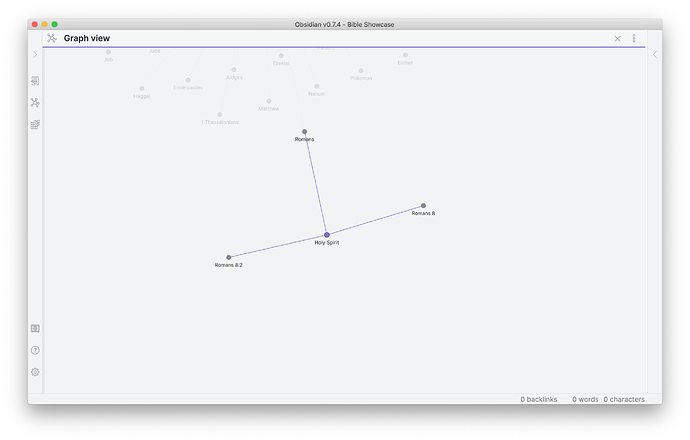Thank you all for your responses and takes on how to engage with the Bible in Obsidian. It has been very insightful. I’ll elaborate some more on the workflow on which I settled and the strengths and drawbacks of that method.
First off I’ll talk a bit more about my use case.
Use case
Within Obsidian there are three mechanics I use: Hard links, Embeds and Backlinks.
- Hard links: When receiving teaching on a specific topic, I want to be able to reference the mentioned Bible verse quickly.
- Embeds: If necessary, I want to be able to embed parts of Scripture conveniently into existing notes.
- Backlinks: When navigating to a specific Book/Chapter/Verse I want to see all of the references in other notes to that specific text. If I am asked to speak on a specific part of the Bible I can see all of the context in one place.
I hope this has been a helpful representation of what my use case is. I would really appreciate your suggestions on follow-up questions.
Method 1: Each verse is one note
This was my initial approach. I want to see backlinks for Books/Chapters/Verses. Whenever I referenced a specific verse I linked to three notes: The book it was in, the chapter in that book and the verse.
I would reference Romans 8:2 as such: [[Romans]] [[Romans 8 | 8]][[Romans 8:2 | :2]]. This renders as [[Romans 8:2]]. 1
This is how it’s presented in the graph view:
Strengths
The strength of this approach is in the use case of backlinks. In the note Romans I can see all backlinks pertaining to that book, in the note Romans 8, all regarding the chapter and in Romans 8:2 all regarding the verse.
Drawbacks
When importing the Bible into Obsidian having one note for each verse gets blown way out of proportion. That would mean over 30 000 notes. Because each chapter note should contain all of its verse notes that is also a ton of embedding.
Method 2: Each book is a note
This is my current method that I use while importing the Bible into Obsidian. Each chapter is a level 1 heading (# Matthew 1), each verse a level 2 heading (## Matthews 1:1). This is how the Gospel of Matthew looks like for example:
This is pretty much what @bdillahu has proposed:
It’s also a very similar workflow to @Lithou’s.
Strengths
Embedding verses and even Chapters is now very straightforward by referencing the specific headers.
Here is an example note:
Referencing either Books, Chapters or Verses is also very straightforward using Heading links.
Drawbacks
In this method, backlinks suffer a bit. Backlinks to specific headers aren’t ordered in the backlinks panel. If I am looking for backlinks to a specific verse, I need to navigate through all of the chapter’s backlinks.
Additionally, the headings obstruct longer Bible reading within Obsidian. Even when embedding the headings are annoying.
As pointed out, there is also no straightforward way to quote multiple verses or even a sentence trailing over multiple verses:
Conclusion
I believe the current drawbacks of the one book, one note approach will eventually be smoothed out.
Regarding the obstructing heading a workaround has been provided in this thread and there are even more workarounds and suggestions in a different thread.
.
In another thread there is a similar discussion on referencing bible verses and block referencing. There is also a Plugin idea for toggling hidden UIDs.
There is also a feature request for having Backlinks appear for linked headings.
So I think as development progresses, this workflow of organising the Bible will get more straightforward.
How to import the Bible
Once I have imported and formatted the whole Bible into a Markdown, it would be easiest for me to share that file but I am quite sure that violates the publisher’s (in my case ESV) guidelines. Unless someone else has a better insight (or I contact the publisher) I wouldn’t want to share a Markdown copy, although I believe you can find some online.
I believe I can share the script I used though. It is a basic AppleScript which copies and formats the chapters. In order for it to work for you, it would need a bit of tweaking. If someone finds flaws, I’d be grateful for suggestions/corrections. You can find the script in this pastebin here.
Advanced Use
Thank you, @Lithou for explaining your workflow in such depth. It is exciting what Obsidian/a Zettelkasten system in general opens up when it comes to personal study. Your approach is very inspiring.
I’d be curious, why are you using a new note for each chapter rather than note for each book and subheadings?
1: This way of writing is a bit tedious that’s why I use Espanso for the text expansion. You can find the script I use here: Bible Verse Script.


